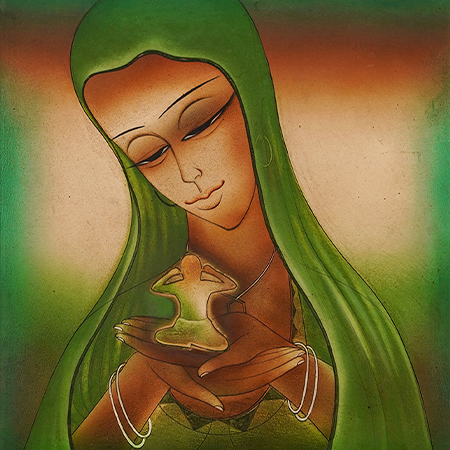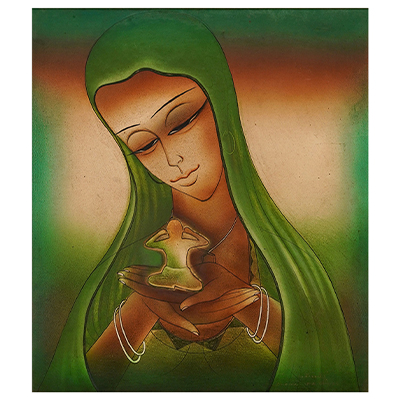Artists Profile

Dharmendra Rathore
(B. 1965)He is an Indian artist deeply connected to his roots and the rich cultural tradition of Rajasthan, which has been a significant influence on his work. Born in Salari, a small village in the Ajmer region of Rajasthan, Rathore’s early exposure to the vibrant cultural landscape, folk art, and festivities of his region shaped his artistic vision. He has always sought to enhance and evolve the traditions of miniature painting and folk art, while integrating them with contemporary themes and global issues.
Rathore pursued his formal education in fine arts, starting with a diploma in fine arts from the Rajasthan School of Art (1985–1990). His journey continued in Delhi, where he enrolled in the Delhi College of Art in 1991. During his time in Delhi, he was mentored by prominent artists such as O P Sharma, Biren De, and Gopi Gajwani, who helped shape his artistic perspective. Rathore was known for his creativity, especially during his college days, when he created larger canvases, and he even had the biggest studio on the campus.
Initially, Rathore favored abstract art, but his later works took a shift toward the figurative, as he sought to communicate more directly with the public. His early works were also influenced by the theme of war and peace, particularly inspired by Leo Tolstoy’s “War and Peace”. The Gulf War of the early 1990s had a significant impact on him, leading him to create a series of works on the grim reality of the conflict, which he saw as a global tragedy.
Rathore’s art is not just about visual aesthetics but also has a deeper social purpose. He believes in the notion of "art for the public," often tackling social issues and trying to use art to address noble causes. His works reflect a keen awareness of history, art, and the medium, and he continuously explores the transition of artistic traditions in modern contexts. This approach led to his first solo exhibition at Vadehra Art Gallery in New Delhi, where his works focused on social issues.
After completing his master's degree and working for a few years in Delhi, Rathore returned to Rajasthan to immerse himself in the regional art scene. Here, he integrated his local roots with broader themes, addressing societal concerns. His works often delve into philosophical and spiritual realms, particularly influenced by Buddhism and the philosophy of peace, as seen in his Buddha series, which he showcased in his solo show, “Visual Resonance” at Art Alive Gallery, New Delhi in 2001.
Rathore’s artistic shift from abstraction to figurative art was driven by his desire to create works that would be accessible and easily understood by a wider audience. The Buddha imagery in his paintings exudes a sense of calm and serenity, guiding viewers on a journey of spiritual reflection. This spiritual and mythological approach is rooted in his family’s traditions, which have significantly shaped his philosophical outlook.
Throughout his career, Rathore has held several notable solo exhibitions at prestigious galleries like Vadehra Art Gallery, Art Alive Gallery, Jehangir Art Gallery, Bajaj Art Gallery, and Lalit Kala Akademi. His works have been featured in numerous exhibitions both within India and internationally.
Rathore’s artistic journey has been recognized through fellowships from organizations such as AIFACS, the State Lalit Kala Akademi, and the Ministry of Human Resource Development (HRD).
His commitment to his roots, his quest for social relevance, and his dedication to creating art for the public ensure his enduring presence in the art world.
